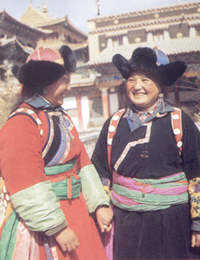 The Tibetan ethnic minority, with a population of 4,593,330 (by 1990), mostly lives in the Tibet Autonomous Region. There are also Tibetan communities in Qinghai, Gansu, Sichuan and Yunnan provinces.
The Tibetan ethnic minority, with a population of 4,593,330 (by 1990), mostly lives in the Tibet Autonomous Region. There are also Tibetan communities in Qinghai, Gansu, Sichuan and Yunnan provinces.
With a long history, Tibetans have their own language and letters. The Tibetan language belongs to the Tibetan sub-branch of the Tibeto-Burman Austronesian of the Chinese-Tibetan Phylum. According to geographical divisions, it has three major local dialects: Weizang, Kangba and Ando. The Tibetan script, an alphabetic system of writing, was created in the early 7th century. With four vowels and 30 consonants, it is used in all areas inhabited by Tibetans.
The Tibetans first settled along the middle reaches of the Yaluzangbu River in Tibet. At the beginning of the 7th century, King Songzan Gambo began to rule the whole of Tibet and made "Losha" (today's Lhasa) the capital. He designated official posts, defined military and administrative areas, created the Tibetan script, formulated laws and unified weights and measures, thus establishing the slavery kingdom known as "Bo", which was called "Tubo" in Chinese historical documents.
After the Tubo regime was established, the Tibetans increased their political, economic and cultural exchanges with the Han and other ethnic minorities in China. In 641, King Songzan Gambo married Princess Wen Cheng of the Tang Dynasty (618-907). In 710, King Chide Zuzain married another Tang princess, Jin Cheng. The two princesses brought with them the culture and advanced production techniques of Central China to Tibet. From that time on, emissaries traveled frequently between the Tang territory and Tibet. The Tibetans sent students to Chang'an, capital of the Tang Dynasty, and invited Tang scholars and craftsmen to Tibet. These exchanges helped promote relations between the Tibetans and other ethnic groups in China and stimulated social development in Tibet.
From the 10th to 12th century, Tibet fell apart into several independent regimes. The Yuan Dynasty (1279-1368) founded by the Mongols in the 13th century brought the divided Tibet under the unified rule of the central government. During the Qing Dynasty (1644-1911), the emperor conferred the titles of the "Dalai Lama" (1653) and "Bainqen Erdini" (1713) on two living Buddhas of the Gelugba sect of Lamaism. The Qing court began to appoint a high resident commissioner to help with local administration in 1728, and set up the Kasha as the local government in 1751. The Tibet proper was liberated peacefully in 1951.
The Tibetans are engaged in stockbreeding and agriculture, with highland barley as the main crop and sheep, goat and yak as the main livestock. Yaks are known as the "Boat of the Plateau".
Tibetan architecture is unique in style, with buildings neatly arranged or rising like magnificent towers and castles. The Potala Palace in Lhasa, group architecture with the highest altitude in the world, was built on the sunny side of a mountain slope. With golden roofs and whitewashed walls, the building rises naturally with the slope, looking extremely imposing. It is a masterpiece of Tibetan architecture, with superb paintings, statues and precious cultural relics.
The Tibetans have produced vast collections of first-class achievements in areas of astronomy, medicine, literature, drama, painting, sculpture and architecture. Tibetan medicine has a history of more than 3,000 years. Incorporating elements of medical theory and practice from the Han and India peoples, Tibetan medicine developed into its own system. The famous workFour Volumes of the Tibetan Medicinewas written in the 7th century.
Tibetans are also good dancers and singers. Their dancing is beautiful with movements executed either with the arms and waist or with legs and feet, and the tap dance is most typically Tibetan. The Tibetan opera is one of the famous opera forms in China. They welcome their guests with kadag (a long piece of white cloth presented to express great respect and wishes of good luck for the guests).
Tibetans believe in Lamaism (a branch of Buddhism). Buddhism was introduced in the 13th century and from the 13th to 16th centuries Buddhism prevailed in Tibet.
The Tibetans have their own calendar, in which November 1st is their New Year. The Tibetan New Year is the most important festival in Tibet. Other main Tibetan festivals include the Shoton Festival, the Great Prayer Festival, the Butter Lamp Festival, the Saga Dawa Festival, the Gyangtse Horse-Race Festival, the Nakchu Horse-Race Festival, and the Yarlung Culture Festival.
